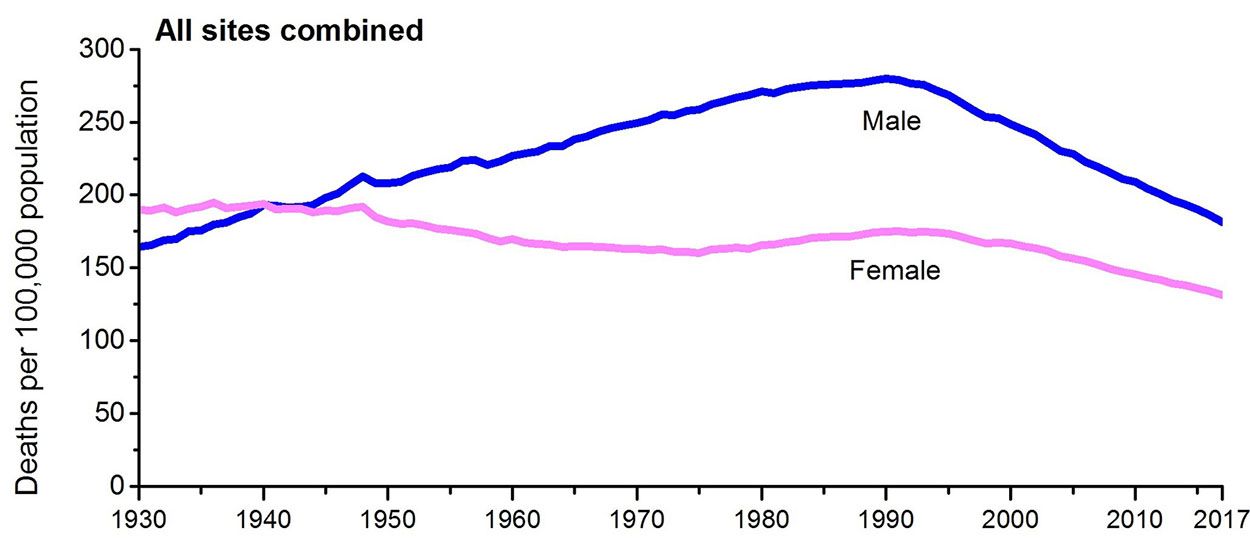
🔬 Cancer rates see largest ever single-year drop in mortality
Fewer and fewer people are dying from cancer in the United States every year, with 2017 showing the largest single-year drop in cancer mortality ever reported.
Share this story!
The cancer death rate declined by 29% from 1991 to 2017, including a whopping 2.2% drop from 2016 to 2017.
Overall cancer death rates dropped by an average of 1.5% per year during the most recent decade of data (2008-2017), continuing a trend that began in the early 1990s and resulting in the 29% drop in cancer mortality in that time.

The drop translates to approximately 2.9 million fewer cancer deaths than would have occurred had mortality rates remained at their peak. Continuing declines in cancer mortality contrast with a stable trend for all other causes of death combined, reflecting a slowing decline for heart disease, stabilizing rates for cerebrovascular disease, and an increasing trend for accidents and Alzheimer disease.
The steady 26-year decline in overall cancer mortality is driven by long-term drops in death rates for the four major cancers—lung, colorectal, breast, and prostate, although recent trends are mixed.
The pace of mortality reductions for lung cancer—the leading cause of cancer death—accelerated in recent years (from 2% per year to 4% overall) spurring the record one-year drop in overall cancer mortality. In contrast, progress slowed for colorectal, breast, and prostate cancers.
The news comes from Cancer Statistics 2020, the latest edition of the American Cancer Society’s annual report on cancer rates and trends. The article appears early online in CA: A Cancer Journal for Clinicians, and is accompanied by a consumer version, Cancer Facts & Figures 2020.
This progress is likewise reflected in the overall melanoma death rate, which dropped by 7% per year during 2013-2017 in people ages 20 to 64, compared to declines during 2006-2010 (prior to FDA approval of ipilimumab and vemurafenib) of 2%-3% per year in those ages 20 to 49 and 1% per year in those ages 50 to 64. Even more striking are the mortality declines of 5% to 6% in individuals 65 and older, among whom rates were previously increasing.
Highlights from the report:
- The death rate for breast cancer dropped by 40% from 1989 to 2017.
- The death rate for prostate cancer dropped by 52% from 1993 to 2017.
- The death rate for colorectal cancer dropped by 53% from 1980 to 2017 among males and by 57% from 1969 to 2017 among females.
- Decades-long rapid increases in liver cancer mortality appear to be abating in both men and women.
- Progress for hematopoietic and lymphoid malignancies (leukemias and lymphomas) has been especially rapid due to improvements in treatment protocols, including the development of targeted therapies. The 5-year relative survival rate for chronic myeloid leukemia increased from 22% in the mid-1970s to 70% for those diagnosed during 2009 through 2015, and most patients treated with tyrosine kinase inhibitors now experience nearly normal life expectancy.
- The overall cancer incidence rate in men declined rapidly from 2007 to 2014, but stabilized through 2016, reflecting slowing declines for colorectal cancer and stabilizing rates for prostate cancer.
- Cancer survival has improved since the mid-1970s for all of the most common cancers except cervical and uterine cancers. Stagnant survival rates for these cancers largely reflect a lack of major treatment advances for patients with recurrent and metastatic disease.
“The accelerated drops in lung cancer mortality as well as in melanoma that we’re seeing are likely due at least in part to advances in cancer treatment over the past decade, such as immunotherapy,” said William G. Cance, M.D., chief medical and scientific officer for the American Cancer Society. “They are a profound reminder of how rapidly this area of research is expanding, and now leading to real hope for cancer patients.”
Reprinted from the American Cancer Society
By becoming a premium supporter, you help in the creation and sharing of fact-based optimistic news all over the world.


